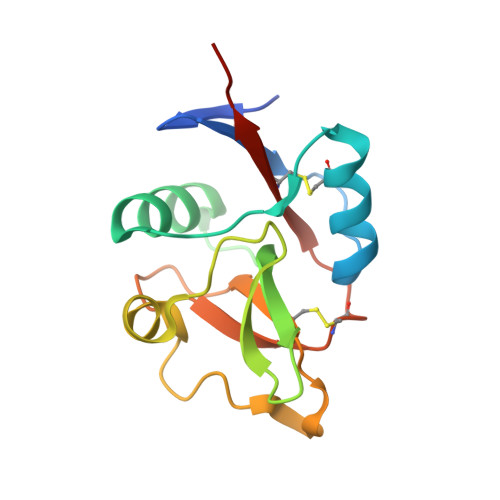Common polymorphisms in human langerin change specificity for glycan ligands.
Feinberg, H., Rowntree, T.J., Tan, S.L., Drickamer, K., Weis, W.I., Taylor, M.E.(2013) J Biol Chem 288: 36762-36771
- PubMed: 24217250
- DOI: https://doi.org/10.1074/jbc.M113.528000
- Primary Citation of Related Structures:
4N32, 4N33, 4N34, 4N35, 4N36, 4N37, 4N38 - PubMed Abstract:
Langerin, a C-type lectin on Langerhans cells, mediates carbohydrate-dependent uptake of pathogens in the first step of antigen presentation to the adaptive immune system. Langerin binds a diverse range of carbohydrates including high mannose structures, fucosylated blood group antigens, and glycans with terminal 6-sulfated galactose. Mutagenesis and quantitative binding assays indicate that salt bridges between the sulfate group and two lysine residues compensate for the nonoptimal binding of galactose at the primary Ca(2+) site. A commonly occurring single nucleotide polymorphism (SNP) in human langerin results in change of one of these lysine residues, Lys-313, to isoleucine. Glycan array screening reveals that this amino acid change abolishes binding to oligosaccharides with terminal 6SO4-Gal and enhances binding to oligosaccharides with terminal GlcNAc residues. Structural analysis shows that enhanced binding to GlcNAc may result from Ile-313 packing against the N-acetyl group. The K313I polymorphism is tightly linked to another SNP that results in the change N288D, which reduces affinity for glycan ligands by destabilizing the Ca(2+)-binding site. Langerin with Asp-288 and Ile-313 shows no binding to 6SO4-Gal-terminated glycans and increased binding to GlcNAc-terminated structures, but overall decreased binding to glycans. Altered langerin function in individuals with the linked N288D and K313I polymorphisms may affect susceptibility to infection by microorganisms.
Organizational Affiliation:
From the Department of Life Sciences, Imperial College, London SW7 2AZ, United Kingdom and.
















